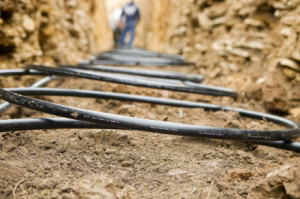Geothermal heating and cooling: everything you’ve ever wanted to know
 Geothermal energy for your home is a way to heat your house using the earth’s natural heat, instead of using fuel. Just below the surface of the ground there is warmth. It makes sense when you think about it. In school you learned that the Earth’s core is molten lava. So you know that inside the earth it is very hot. The temperature inside the earth gets cooler closer to the surface. Several feet below the surface, the ground has a constant temperature of about 50°F. That is why some animals will burrow into the ground to stay warm during winter. Geothermal heating & cooling is the technology that uses that constant temperature to heat your home in winter, and to cool it in summer.
Geothermal energy for your home is a way to heat your house using the earth’s natural heat, instead of using fuel. Just below the surface of the ground there is warmth. It makes sense when you think about it. In school you learned that the Earth’s core is molten lava. So you know that inside the earth it is very hot. The temperature inside the earth gets cooler closer to the surface. Several feet below the surface, the ground has a constant temperature of about 50°F. That is why some animals will burrow into the ground to stay warm during winter. Geothermal heating & cooling is the technology that uses that constant temperature to heat your home in winter, and to cool it in summer.
Components of a geothermal system
There are three basic components of a geothermal HVAC (Heating, Ventilation, Air Conditioning) system for you home: The ground loop (pipes), a heat pump, and an air delivery system.
Pipes are used to transfer the heat from below the ground, up to your house. Usually liquid, but sometimes air, runs through the pipes being warmed by the earth’s heat. A heat pump, where a contained refrigerant-liquid is held and compressed, raises the temperature up to 100°F. A heat exchanger removes the heat to then use in the house, for winter heating purposes. This process also works in reverse, taking heat out of your house, sending it back into the earth, cooling the air in the summer. Your house water can be heated with this same process.
The pipes can run vertically, in a deep and narrow path, or they can be laid out horizontally. This depends on the needs of your home, and the ground surrounding it. The cost of installing a geothermal system depends on these things. Other factors include the type of ground on your property and the depth to which is needed to reach the ideal temperature.
Benefits of geothermal heat
The upsides of having a geothermal energy system include cleaner air, since you won’t be using fuel oil for heating, and it is cheaper than using oil. Most people say that the geothermal energy is more consistent as well. When you use a furnace, you get areas of the house that are hot and areas that remain cold, the same goes for air conditioning. Geothermal heating and cooling creates a consistent temperature throughout your entire home.
The downside of geothermal energy is the upfront cost of installation, and the installation itself. Even after rebates it takes a few years for the system to pay off. You will also use more electricity, because the heat pump requires electricity to work. However, as fuel costs climb higher every year, it is still less expensive to use a little more electricity, rather than fuel. Installing the pipes into your property can be challenging. If your ground requires horizontal pipes, a large part of your landscaping will be torn up to install it. Vertical pipes require less destruction of your yard, but will have to go deeper into the ground, which will cost more. Costs will vary, depending on the size of your home, the ground used for the system, the type of system required for your situation, and the amount of labor involved in installation.
On the bright side, over the past few years the average cost of installation decreased by nearly half. As a bonus for going “green” there are rebates & tax incentives for installing geothermal energy, from both the federal government and state programs. These programs vary year to year, and some of the rebates offered are waiting list programs, so be aware that you might have to wait for a couple years to get your rebate. Regardless, most people who have converted to geothermal energy are happy with the results. If you’re ready to take your home from the industrial age into the new age of being green, look into geothermal energy.
Have more questions about geothermal heating and cooling? Leave a comment below or contact us at 216-663-6462.

